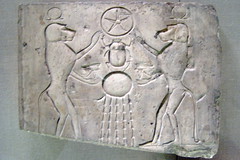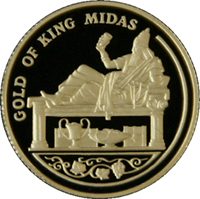![Photo by Nic McPhee, Creative Commons [CC-BY-SA-2.0], via Wikimedia Commons pharaoh ramses royal cartouches](http://www.mythphile.com/wp-content/uploads/2012/03/ramses-300x298.png)
Ramses the Great's multiple ruling names tell who's boss (Photo Credit: Nic McPhee, Creative Commons)
U.S. Secret Service code names have been used to refer to the president and VIPs since the Truman Administration. I find them fascinating, because they are a modern expression of a very old mythological theme, the Magic Name or Secret Name.
Names have power in both mythology and psychology. In many mythologies, speaking a name brings that thing into being, or at least helps reaffirm its existence. For many, one’s secret name or code name is a form of self-affirmation and identity. From the Egyptian sun-god Re to Rumpelstiltskin, the secret “true name” of a person gave you magical power over them. Kings and leaders traditionally adopt special ruling names that signify their ruling identity like a crest or coat of arms. Secret societies use secret, ceremonial names to confer a sense of membership in an elite, “in the know” inner circle. These secret names also convey a sense of taboo, of risk, of danger from those outside.
When secret service names were internal, not known by the general public, they served an almost totemic purpose. The code name meant “important person to be protected.” Those who knew the name were part of a secret society, a Praetorian Guard, a priesthood, committed to the defense of this totem-like (and implicitly defenseless-without-us) individual. The secret name would also serve as a point of focus, a rallying cry, reminding the inner circle that heard that secret name daily who and what their president was and stood for. The code name served as a psychological mantra for that administration.
Once code names became more common knowledge, they became political, distilling the candidate into a mascot, emblem, figurehead, and an embodiment of a certain ideal. The code name can serve as powerful one-word and a coded message to constituents (and opponents). As George Lakoff famously wrote in Don’t Think Of An Elephant!, coded language, shorthand phrases used to evoke political positions and work on people’s unconscious psychology, have been a powerful factor in elections of the last decade.
Code names are selected by the White House Communications Agency, normally consulting with the person who will hold the name. Some of them are surprising choices! Here’s an overview of just a few secret service names:
- Ironically, Truman went by “General,” while Eisenhower more humbly went by “Providence.” “Providence” is a word with layers of meaning: it may indicate Eisenhower’s faith and his crediting the Almighty with his deeds, or it may show that he viewed the office of “President” as “Provider,” a more active role.
- Kennedy was “Lancer,” probably an allusion to “Camelot” expressing his vigor and knight-like persona. His other family members, as with most family members of presidents, took names starting with the same letter that were not quite so Arthurian (“Lace” for Jacqueline Kennedy, for example, expresses her fashion sense.)
- As for LBJ, I would have expected a cowboy name, like Reagan with the macho name “Rawhide,” but in fact Johnson’s was “Volunteer,” which sounds to me like a self-reminder that he was in the country’s service.
- Jimmy Carter, who recently wrote a Bible commentary, was “Deacon,” a religious name that is both slightly snobbish and humble (no “Warrior” or “Rawhide” or “General” here).
- Intriguingly, George W. Bush started out (I think?) with “Tumbler” and went to “Trailblazer” for more of a sense of leadership and less of an implication of flexibility (or falling over himself).
- Birds are common, which is true of mythological names as well: Bill Clinton chose the all-American “Eagle” and John McCain, perhaps referring to his Vietnam ordeal, chose “Phoenix.”
- “Javelin” probably refers to Mitt Romney’s first car, made by his father’s car company. I have yet to see news sites make the connection with “Lancer,” but a javelin is essentially a throwing lance. (Some have also tied it to Romney’s involvement with the Winter Olympics, but to be strictly accurate, which myths aren’t, javelin was not part of the Winter Olympics.)
- It’s Santorum’s code name that intrigues me. Obviously, “Petrus” refers to St. Peter, the “Rock” on which Jesus proposed to found his church. But Petrus is medieval Latin, a Latinized corruption of the Greek Petros seen in the New Testament. I suppose I’m being an overeducated “snob” to think he should have used the correct Biblical form, Petros. But the odd spelling made me think of medieval prophesies foretelling Petrus Romanus as the last pope. The modern apocalyptic 2012 movement refers to Petrus Romanus frequently. I can’t help wondering: is Santorum hinting that he will symbolically fulfill that role?
Photo credit for “Ramses” image above:






